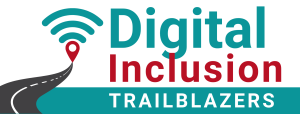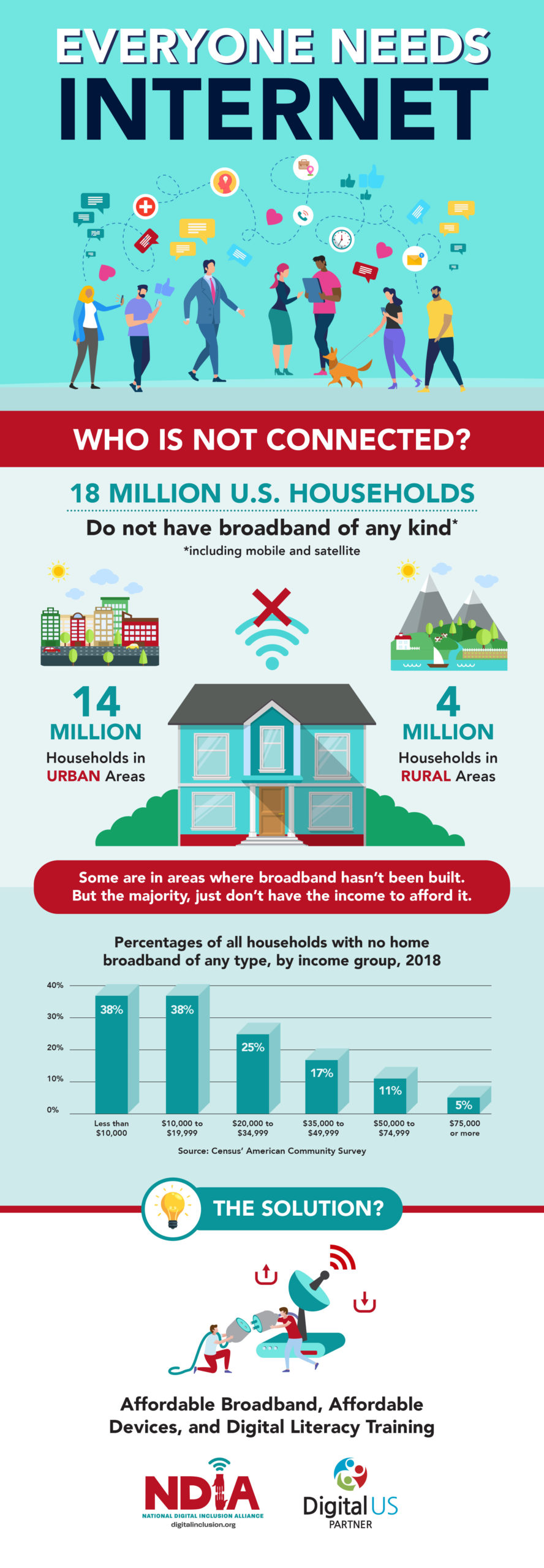AWARENESS
Educate policymakers, the media, and potential partners about the need for digital equity and the work of local digital inclusion programs.Net Inclusion, NDIA’s annual conference, is back in person! Join hundreds of digital inclusion community practitioners, advocates, academics, internet service providers, and policymakers to discuss:
- local, state, Tribal and federal policies and policy innovations impacting digital equity
- sources of financial and programmatic support of digital inclusion programs
- digital inclusion best practices from across the country
Digital Inclusion Week is an annual week that highlights the digital inclusion movement and raises awareness of digital equity in communities throughout the country. During DIW, hundreds of organizations, advocates, and local/regional elected officials raise awareness for solutions addressing home internet access, devices, and digital skills training and support programs.
Named for Charles Benton, the founder of the Benton Foundation, the award recognizes leadership and dedication in advancing digital equity. Digital Equity Champions promote the ideal of accessible and affordable communications technology for all Americans in crafting programs and policies that make it a reality.
Digital Inclusion Trailblazers is the first public inventory of local government initiatives promoting digital literacy and broadband access for underserved residents. Initially launched in 2016 as an advocacy tool for local, state and national digital inclusion leadership. NDIA has revamped the indicators. NDIA maintains an up to date list of local government Digital Inclusion Trailblazers as a handy database of examples for communities interested in taking similar steps themselves.
NDIA releases White Papers on many important digital inclusion topics, the most popular including:
- Defining a State Digital Equity Office: State governments are essential partners for closing the nation’s digital divides and ensuring their citizens have both the access to affordable, robust broadband internet service and the internet enabled devices, digital literacy training, and technical support they need in order to fully benefit from the opportunities the internet promises. This document outlines NDIA’s recommendations for states as they assume digital inclusion work followed by a list of recommended functions and activities states should engage in to increase digital equity throughout their state.
- Digital Divide and Structural Racism: The federal government’s existing broadband programs target tens of billions of dollars to expand broadband availability for residents of “unserved and underserved” rural areas, while studiously ignoring tens of millions of urban Americans who still lack high-speed internet service. This policy framework is counterproductive for reducing the nation’s overall digital divide. It is also structurally racist, discriminating against unconnected Black Americans and other communities of color.
- White Paper: Tier Flattening: In recent years AT&T and Verizon have eliminated their cheaper rate tiers for low and mid-speed Internet access, except at the very slowest levels. This policy of upward “tier flattening” raises the cost of Internet access for urban and rural AT&T and Verizon customers who only have access to the oldest, slowest legacy infrastructure.
- AT&T’s Digital Redlining Of Cleveland: A mapping analysis of Federal Communications Commission broadband availability data, conducted by Connect Your Community and the National Digital Inclusion Alliance, strongly suggests that AT&T has systematically discriminated against lower-income Cleveland neighborhoods in its deployment of home Internet and video technologies over the past decade.
To see other White Papers, check out NDIA’s Publications page.
U.S. Representative Brenda L. Lawrence (MI-14) and FCC Commissioner Geoffrey Starks virtually hosted, “Connecting Michigan: From Internet Inequality to Digital Equity” which explored how the digital divide has exacerbated already existing inequities throughout Michigan. The panelists discuss how these inequalities impact both cities and rural areas of Michigan, how these areas mirror the same struggles across the county and what solutions need to be taken.
Panelists
U.S. Representative Elissa Slotkin (MI-08)
Michigan Lt. Governor Garlin Gilchrist II
Joshua Edmonds, City of Detroit
Amina Fazlullah, Common Sense Media
Mike Muse, The Mike Muse Show on SiriusXM
Angela Siefer, National Digital Inclusion Alliance
EVERYONE NEEDS INTERNET
All data in this infographic are from the U.S. Census’ 2018 American Community Survey 1-Year Estimates or 5-Year Estimates.
- Total U.S. households with no home broadband subscription of any type — 1-Year Estimates, Table B28002
- U.S. households with no home broadband of any type located in urban vs. rural areas: NDIA calculation based on…
- Percentages of U.S. households with no home broadband of any type in urban and rural areas — 1-Year Estimates, Table GCT2801
- Numbers of U.S. households located in urban and rural areas — 5-Year Estimates, Table S1901
- U.S. households with no home broadband of any type by household income — 1-Year Estimates, Table B28004
In the Media
On federal and state levels, plans are underway to enhance internet access
Morning Edition, NPR, May 17, 2022
'Digital Divide Poses Problems'
Black News Channel, October 15, 2021
Digital Equity Takes Center Stage in U.S. Cities Post COVID
Government Technology, March 2022
Techquity: Unlocking Economic Opportunity By Removing The Digital Divide
Forbes, August 12, 2021
Using data to boost digital literacy? There's a new guide for states
StateScoop, April 21, 2022
Calming computer jitters: Help for the elderly who aren’t tech-savvy
Washington Post, July 11, 2021





